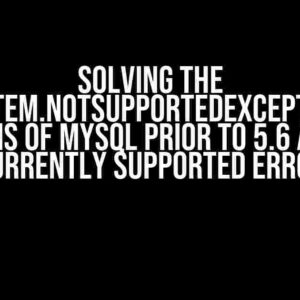Are you tired of encountering pesky exceptions when trying to serialize your stylish XAML code using XamlWriter and XamlReader in .NET 9? You’re not alone! This article is here to guide you through the troubleshooting process, providing clear and direct instructions to help you conquer this serialization conundrum.
The Problem: What’s Causing the Serialization Exception?
Before we dive into the solution, let’s take a step back and understand what’s causing the exception in the first place. In .NET 9, the XamlWriter and XamlReader classes have undergone significant changes, which have led to compatibility issues with previous serialization approaches.
The XamlWriter class is responsible for serializing XAML objects into a string or stream, while the XamlReader class deserializes XAML data from a string or stream back into an object. However, in .NET 9, the serialization process has become more stringent, leading to exceptions when using the traditional approaches.
XamlWriter and XamlReader Exception Examples
Here are some common exception examples you might encounter when using XamlWriter and XamlReader in .NET 9:
System.Xaml.XamlException: 'Cannot serialize Member 'MyProperty' because it is a markup extension.'
System.Xaml.XamlException: 'Cannot deserialize XAML file because of a missing namespace.'
These exceptions can be frustrating, especially when you’re trying to upgrade your existing .NET project to the latest framework.
The Solution: Serialization Best Practices for .NET 9
Luckily, with a few tweaks and adjustments, you can overcome these serialization exceptions and get your XAML code working smoothly in .NET 9. Follow these best practices to ensure successful serialization:
1. Use the XamlSerializer Class Instead of XamlWriter
In .NET 9, the XamlSerializer class has replaced XamlWriter as the recommended serialization method. XamlSerializer provides a more robust and flexible way of serializing XAML objects.
using System.Xaml;
using System.Xaml.Markup;
// Create an instance of XamlSerializer
XamlSerializer serializer = new XamlSerializer();
// Serialize your XAML object
string xamlString = serializer.Serialize(yourXamlObject);
2. Specify the XAML Namespace and Assembly
To avoid namespace-related exceptions, make sure to specify the XAML namespace and assembly when serializing and deserializing your XAML code.
using System.Xaml;
using System.Xaml.Markup;
// Specify the XAML namespace and assembly
XamlXmlReaderSettings settings = new XamlXmlReaderSettings
{
Namespace = "http://schemas.microsoft.com/winfx/2006/xaml/presentation",
Assembly = typeof(MyXamlObject).Assembly
};
// Create an instance of XamlReader
XamlXmlReader xamlReader = new XamlXmlReader(yourXamlString, settings);
// Deserialize your XAML object
MyXamlObject deserializedObject = xamlReader.ReadObject() as MyXamlObject;
3. Use the XamlSetMarkupExtensionAttribute to Mark Markup Extensions
When serializing XAML objects with markup extensions, use the XamlSetMarkupExtensionAttribute to mark them correctly. This attribute helps the XamlSerializer to recognize and handle markup extensions properly.
using System.Xaml.Markup;
// Mark the markup extension with XamlSetMarkupExtensionAttribute
[XamlSetMarkupExtensionAttribute("MyMarkupExtension")]
public class MyXamlObject
{
//Your XAML object properties and methods
}
4. Avoid Using Anonymous Types and Dynamic Objects
In .NET 9, anonymous types and dynamic objects are not serializable by default. To avoid exceptions, use concrete types or implement custom serialization logic for these types.
// Avoid using anonymous types
var anonymousType = new { Name = "John", Age = 30 };
// Instead, use concrete types
public class Person
{
public string Name { get; set; }
public int Age { get; set; }
}
Troubleshooting Common Serialization Issues
Even with the best practices in place, you might still encounter serialization issues in .NET 9. Here are some common issues and their solutions:
Issue 1: XamlWriter does not serialize properties with default values
Solution: Use the XamlSerializer class instead of XamlWriter, and set the ShouldSerialize property to true for properties with default values.
[XamlSerializable]
public class MyXamlObject
{
[ShouldSerialize(DefaultValue = true)]
public string MyProperty { get; set; }
}
Issue 2: XamlReader throws an exception when deserializing XAML data
Solution: Verify that the XAML namespace and assembly are specified correctly when deserializing the XAML data. Also, ensure that the XAML data is well-formed and matches the expected schema.
// Verify the XAML namespace and assembly
XamlXmlReaderSettings settings = new XamlXmlReaderSettings
{
Namespace = "http://schemas.microsoft.com/winfx/2006/xaml/presentation",
Assembly = typeof(MyXamlObject).Assembly
};
Conclusion
In conclusion, overcoming XamlWriter and XamlReader exceptions in .NET 9 requires a combination of best practices, such as using the XamlSerializer class, specifying the XAML namespace and assembly, marking markup extensions, and avoiding anonymous types and dynamic objects.
By following the guidelines outlined in this article, you’ll be well on your way to successfully serializing your stylish XAML code in .NET 9. Remember to stay vigilant and adapt to the ever-changing landscape of .NET serialization.
Additional Resources
If you’re looking for more information on .NET serialization and XAML, check out these additional resources:
- Microsoft Documentation: Serializing XAML
- Microsoft Documentation: XamlSerializer Class
- Stack Overflow: XAML Serialization Issue in .NET Core 3.1
| Best Practice | Description |
|---|---|
| Use XamlSerializer instead of XamlWriter | Provides a more robust and flexible way of serializing XAML objects |
| Specify the XAML namespace and assembly | Avoids namespace-related exceptions and ensures correct deserialization |
| Mark markup extensions with XamlSetMarkupExtensionAttribute | Helps the XamlSerializer to recognize and handle markup extensions correctly |
| Avoid using anonymous types and dynamic objects | Ensures serializability and avoids exceptions |
Remember, with the right combination of best practices and troubleshooting skills, you’ll be able to overcome any XamlWriter and XamlReader exceptions in .NET 9!
Frequently Asked Question
Get answers to the most commonly asked questions about the issue of serialization of style using XamlWriter and XamlReader throwing exceptions in .NET 9.
What is the issue with serialization of style using XamlWriter and XamlReader in .NET 9?
In .NET 9, the serialization of style using XamlWriter and XamlReader throws an exception due to changes in the way styles are handled in the new framework. Specifically, the XamlWriter and XamlReader classes are not able to serialize styles that are defined as resources in the XAML file.
Why did this change occur in .NET 9?
The change occurred because the .NET team refactored the way styles are handled in XAML to improve performance and simplify the code. Unfortunately, this refactoring broke the serialization of styles using XamlWriter and XamlReader.
How can I fix this issue in my .NET 9 application?
One possible solution is to use the XamlServices class instead of XamlWriter and XamlReader. XamlServices provides a more flexible and powerful way to serialize and deserialize XAML. Alternatively, you can try using the StyleSerializer class from the Windows.UI.Xaml.Markup namespace.
Will this issue be fixed in a future version of .NET?
Yes, the .NET team is aware of this issue and is planning to fix it in a future version of .NET. However, there is no official timeline for when this fix will be released.
What are the implications of this issue on my application’s performance?
The implications of this issue on your application’s performance will depend on how you are using styles in your XAML file. If you are heavily relying on serialization of styles, you may experience performance issues or even crashes. However, if you are using styles in a more limited way, the impact may be minimal.


